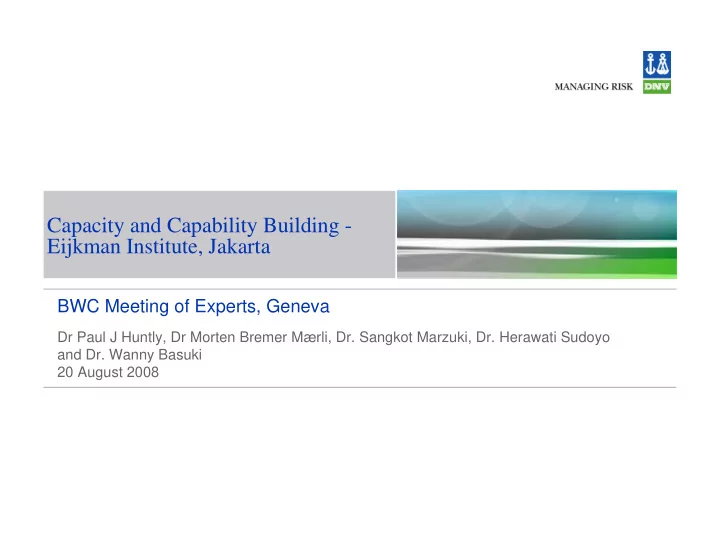

Capacity and Capability Building - Eijkman Institute, Jakarta BWC Meeting of Experts, Geneva Dr Paul J Huntly, Dr Morten Bremer Mærli, Dr. Sangkot Marzuki, Dr. Herawati Sudoyo and Dr. Wanny Basuki 20 August 2008
Objectives � Why biorisk management in containment laboratories are relevant to BWC � Describe the laboratory biorisk management system being designed for the Eijkman Institute � Next steps and possible follow-up 26 August 2008 Version Slide 2
Containment laboratories?
Containment laboratories � No conclusive definition for different laboratory types – guideline / risk based � Organisms categorised by risk group from 1 to 4 � Facilities (and management controls) defined by containment levels ranging from 1 to 4 (e.g. BSL3, PC3, ACDP3, CL3…) � Recent growth of such facilities around the world, including in developing countries 26 August 2008 Version Slide 4
Containment laboratories � Relative sophistication can create confusion and practical difficulties in design, construction and operation � Operators often struggle with: - Identification of recognised good practices - Needs for ongoing maintenance - Operating costs � Combination of engineering and management controls � Accident / incident investigations normally show that management controls fail as opposed to the engineering features 26 August 2008 Version Slide 5
Potential concerns � Potential for harm if work not conducted responsibly: - Intentional harm - Accidental manipulation - Laboratory accidents: - Worker / community infection - Environmental release � Potential source of biological assets including; - Organisms - Equipment - Information - Expertise � Provide response capacity and capability in event of outbreak / attack 26 August 2008 Version Slide 6
Eijkman BSL3 project:
Eijkman Institute � Nobel prize winner Christian Eijkman discovered the cause of beriberi � Situated in Jakarta, Indonesia � Central role in diagnosing H5N1 cases in the country � Have built a BSL3 laboratory but need support in terms of how to operate and maintain � Common problem where facilities are provided but skills and resources to operate are not readily available 26 August 2008 Version Slide 8
Eijkman Institute, Indonesia � Main function to work on emerging infectious diseases and provide capacity and capability � Key milestones - Construction started summer 2006 - Certified March 2007 - Staffing and development of procedures, training, etc. - Operational January 2008 � Currently being used in diagnostic work with avian influenza H5N1 in Indonesia 26 August 2008 Version Slide 9
Challenges � No history of running containment facilities � Need to develop management system has often to be started from basics - Policies - Biosafety manual - SOPs - Risk assessments - Etc. � New personnel - Laboratory manager - Staff - Maintenance � Need own system which fits individual institute and culture � Norwegian Foreign Affairs Ministry Sponsored Project ‘Improving Biosafety in High Containment Laboratories in Indonesia’ 26 August 2008 Version Slide 10
Objectives Establish an effective, best-practice � biorisk management system at the Eijkman Institute, incorporating safety / security management process and associated procedures Develop the necessary document � templates (e.g. risk assessments, microbial inventories, accident / incident reporting forms) Develop the training programmes and � materials to support the above Develop a generic model which can be � applied in other institutes in Indonesia and elsewhere Enhance communication around biorisk � management and capacity building at all levels 26 August 2008 Version Slide 11
Activities � Define management processes and safety / security processes required for responsible management of biorisk � Review proposed system using international expertise � Conduct training and enhance local capacity and capability � Basis is CWA 15793; Laboratory biorisk Management Standard 26 August 2008 Version Slide 12
Next steps:
What next..? � Finalise Eijkman system and offer for implementation in other labs in developing countries � Integrate with facility orientated projects - Improved standards and specifications - Enhance ability to maintain and run - Reduce complexity and operating costs - Ensure ‘fitness for purpose’ � Regulators - Examine role of regulator and provide local capability and competence for long term � Training, awareness raising and education 26 August 2008 Version Slide 14
Conclusions:
Conclusions � There is a need for facilities like the BSL3 at the Eijkman Institute � Real need to build local and sustainable capacity and capability � Great attention paid to facilities projects - less paid to how these facilities will be organised and managed � We must address the facility, the instructions AND the people if the we are to maintain safe and secure facilities � Next step to widen approach and identify other candidate organisations � Continued international cooperation and support is needed 26 August 2008 Version Slide 16
Slide 17 26 August 2008 Version
Recommend
More recommend